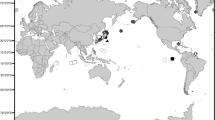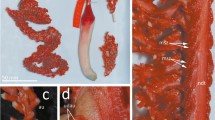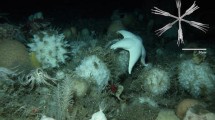Abstract
The biology and systematics of the squid genus Asperoteuthis Nesis, 1980, are poorly known. Although there have been four named and five described species in this genus, it now appears that there are only three valid species: A. acanthoderma (Lu, 1977), A. mangoldae Young, Vecchione & Roper, 2007a, and A. lui Salcedo-Vargas, 1999. Using a combination of mitochondrial DNA sequences (cytochrome c oxidase subunit I [COI], 16S rRNA, and 12S rRNA) and morphology, A. nesisi Arkhipkin & Laptikhovsky, 2008, and Clarke’s (1980) ‘?Mastigoteuthis A’ both appear to be junior synonyms of A. lui. The most distinctive feature of this species is the aboral tentacle club photophore distribution, which is chiral, with more photophores dorsally (∼11–16) than ventrally (∼9–12). Genetically, there is low intraspecific variation within A. lui and higher interspecific variation between this species and other chiroteuthids. Previously only known from the type description, A. lui now appears to have a circumpolar distribution in the Southern Ocean and is the most commonly encountered Asperoteuthis species in the diet of marine predators.









Similar content being viewed by others
References
Alvito PM, Rosa R, Phillips RA, Cherel Y, Ceia F, Guerreiro M, Seco J, Baeta A, Vieira RP, Xavier J (2015) Cephalopods in the diet of nonbreeding black-browed and grey-headed albatrosses from South Georgia. Polar Biol 38(5):631–641. doi:10.1007/s00300-014-1626-3
Arkhipkin AI, Laptikhovsky VV (2008) Discovery of the fourth species of the enigmatic chiroteuthid squid Asperoteuthis (Cephalopoda: Oegopsida) and extension of the range of the genus to the South Atlantic. J Molluscan Stud 74(3):203–207. doi:10.1093/mollus/eyn007
Berry SS (1909) Diagnoses of new cephalopods from the Hawaiian Islands. Proc US Natl Mus 37:407–419. doi:10.5479/si.00963801.37-1713.407
Bloom S-A (2012) Feeding ecology of white-chinned petrels: diet and their diving patterns around South Georgia. Dissertation, Universidade de Coimbra
Bolstad KSR (2010) Systematics of the Onychoteuthidae Gray, 1847 (Cephalopoda: Oegopsida). Zootaxa 9626:1–186
Braid HE, Kubodera T, Bolstad KSR (2016) One step closer to understanding the chiroteuthid families in the Pacific Ocean. Mar Biodiv
Braid HE, Bolstad KSR (2015) Systematics of the Mastigoteuthidae Verrill, 1881 (Cephalopoda: Oegopsida) from New Zealand waters. N Z J Zool 42(3):187–256. doi:10.1080/03014223.2015.1063516
Braid HE, McBride PD, Bolstad KS (2014) Molecular phylogenetic analysis of the squid family Mastigoteuthidae (Mollusca, Cephalopoda) based on three mitochondrial genes. Hydrobiologia 725(1):145–164. doi:10.1007/s10750-013-1775-3
Cherel Y, Duhamel G (2004) Antarctic jaws: cephalopod prey of sharks in Kerguelen waters. Deep Sea Res I 51:17–31. doi:10.1016/j.dsr.2003.09.009
Cherel Y, Weimerskirch H, Trouvé C (2002) Dietary evidence for spatial foraging segregation in sympatric albatrosses (Diomedea spp.) rearing chicks at Iles Nuageuses, Kerguelen. Mar Biol 141:1117–1129. doi:10.1007/s00227-002-0907-5
Cherel Y, Duhamel G, Gasco N (2004) Cephalopod fauna of subantarctic islands: new information from predators. Mar Ecol Prog Ser 266:143–156. doi:10.3354/meps266143
Clarke MR (1980) Cephalopoda in the diet of sperm whales of the southern hemisphere and their bearing on sperm whale biology. Discov Rep 37:1–324
Clarke MR (1986) A handbook for the identification of cephalopod beaks. Clarendon Press, Oxford
Clarke M, Goodall N (1994) Cephalopods in the diets of three odontocete cetacean species stranded at Tierra del Fuego, Globicephala melaena (Traill, 1809), Hyperoodon planifrons Flower, 1882 and Cephalorhynchus commersonii (Lacepede, 1804). Antarct Sci 6(2):149–154. doi:10.1017/s0954102094000234
Gómez-Villota F (2007) Sperm whale diet in New Zealand. Dissertation, Auckland University of Technology
Gray JE (1849) Catalogue of the Mollusca in the collection of the British Museum. Part I. Cephalopoda Antepedia. Printed by order of the Trustees, London. doi:10.5962/bhl.title.21153
Guerreiro M, Phillips RA, Cherel Y, Ceia FR, Alvito P, Rosa R, Xavier JC (2015) Habitat and trophic ecology of Southern Ocean cephalopods from stable isotope analyses. Mar Ecol Prog Ser 530:119–134. doi:10.3354/meps11266
Hebert PDN, Cywinska A, Ball SL, deWaard JR (2003) Biological identifications through DNA barcodes. Proc R Soc Lond B Biol 270:313–321. doi:10.1098/rspb.2002.2218
Joubin L (1933) Notes préliminaires sur les Céphalopodes des croisières du Dana (1921–1922), 4e Partie. Ann Inst Oceanogr 13:1–49
Judkins H, Ingrao DA, Roper CF (2009) First records of Asperoteuthis acanthoderma (Lu, 1977) (Cephalopoda: Oegopsida: Chiroteuthidae), from the North Atlantic Ocean, Straits of Florida. Proc Biol Soc Wash 122(2):162–170. doi:10.2988/08-30.1
Katoh K, Standley DM (2013) MAFFT multiple sequence alignment software version 7: improvements in performance and usability. Mol Biol Evol 30:772–780. doi:10.1093/molbev/mst010
Kubodera T, Watanabe H, Ichii T (2007) Feeding habits of the blue shark, Prionace glauca, and salmon shark, Lamna ditropis, in the transition region of the Western North Pacific. Rev Fish Biol Fish 17:111–124. doi:10.1007/s11160-006-9020-z
Lanfear R, Calcott B, Ho SYW, Guindon S (2012) PartitionFinder: combined selection of partitioning schemes and substitution models for phylogenetic analyses. Mol Biol Evol 29:1695–1701. doi:10.1093/molbev/mss020
Lea M-A, Cherel Y, Guinet C, Nichols PD (2002) Antarctic fur seals foraging in the Polar Frontal Zone: inter-annual shifts in diet as shown from fecal and fatty acid analyses. Mar Ecol Prog Ser 245:281–297. doi:10.3354/meps245281
Lu CC (1977) A new species of squid Chiroteuthis acanthoderma, from the Southwest Pacific (Cephalopoda, Chiroteuthidae). Steenstrupia 4:179–188
Nesis KN (1974) The oceanic cephalopods of the South-Western Atlantic. Trudy Inst Oceanol Acad Sci USSR 98:51–75
Nesis KN (1980) Taxonomic position of Chiroteuthis famelica Berry (Cephalopoda, Oegopsida). Byull Moskovsk Obshch Isp Prir Otd Biol 85:59–66
Nesis KN (1987) Cephalopods of the world (English translation). Tropical Fish Hobbyist (T.F.H.) publications, Neptune City
Nesis KN, Nikitina I (1999) New Genus B. Available online at: http://tolweb.org/New_Genus_B/19460. Accessed 11 April 2016
Pascoe PL, Mickiewicz MC, Castello HP (1990) Cephalopod remains from the stomach of a sperm whale stranded off Patagonia. Mar Biol 104:1–4. doi:10.1007/bf01313150
Rambaut A (2012) FigTree version 1.4.0. Home page at: http://tree.bio.ed.ac.uk/software/figtree
Ratnasingham S, Hebert PDN (2007) BOLD: The Barcode of Life Data System (http://www.barcodinglife.org). Mol Ecol Notes 7:355–364. doi:10.1111/j.1471-8286.2007.01678.x
Ratnasingham S, Hebert PDN (2013) A DNA-based registry for all animal species: the barcode index number (BIN) system. PLoS One 8(7), e66213. doi:10.1371/journal.pone.0066213
Richoux NB, Jaquemet S, Bonnevie BT, Cherel Y, McQuaid CD (2010) Trophic ecology of Grey-headed albatrosses from Marion Island, Southern Ocean: insights from stomach contents and diet tracers. Mar Biol 157:1755–1766. doi:10.1007/s00227-010-1448-y
Rodhouse PG, Clarke MR, Murray AWA (1987) Cephalopod prey of the wandering albatross Diomedea exulans. Mar Biol 96:1–10. doi:10.1007/bf00394833
Roper CFE, Voss GL (1983) Guidelines for taxonomic descriptions of cephalopod species. Mem Natl Mus Victoria 44:49–63
Roper CFE, Young RE (1975) Vertical distribution of pelagic cephalopods. Smith Contrib Zool 209:1–51. doi:10.5479/si.00810282.209
Salcedo-Vargas MA (1995) Systematic value of the ultrastructure of the sucker surface in the squid family Mastigoteuthidae (Mollusca: Cephalopoda). Contrib Zool 65:65–77
Salcedo-Vargas MA (1999) An asperoteuthid squid (Mollusca: Cephalopoda: Chiroteuthidae) from New Zealand misidentified as Architeuthis. Zoosyst Evol 75:47–49. doi:10.1002/mmnz.19990750106
St-Onge M, LaRue B, Charpentier G (2008) A molecular revision of the taxonomic status of mermithid parasites of black flies from Quebec (Canada). J Invertebr Pathol 98:299–306. doi:10.1016/j.jip.2008.04.001
Tamura K, Nei M (1993) Estimation of the number of nucleotide substitutions in the control region of mitochondrial DNA in humans and chimpanzees. Mol Biol Evol 10(3):512–526
Tamura K, Stecher G, Peterson D, Filipski A, Kumar S (2013) MEGA6: molecular evolutionary genetics analysis version 6.0. Mol Biol Evol 30(12):2725–2729. doi:10.1093/molbev/mst197
Tsuchiya K, Okutani T (1993) Rare and interesting squids in Japan, recent occurrences of big squids from Okinawa. Venus 52:299–311
Vaidya G, Lohman DJ, Meier R (2011) SequenceMatrix: concatenation software for the fast assembly of multi-gene datasets with character set and codon information. Cladistics 27:171–180. doi:10.1111/j.1096-0031.2010.00329.x
Verrill AE (1881) Report on the cephalopods and on some additional species dredged by the U.S. Fish Commission Steamer ‘Fish-hawk’, during the season of 1880. Bull Mus Comp Zool 8:99–116
Victor BC, Hanner R, Shivji M, Hyde J, Caldow C (2009) Identification of the larval and juvenile stages of the Cubera Snapper, Lutjanus cyanopterus, using DNA barcoding. Zootaxa 2215:24–36
Xavier JC, Phillips RA, Cherel Y (2011) Cephalopods in marine predator diet assessments: why identifying upper and lower beaks is important. ICES J Mar Sci 68(9):1857–1864. doi:10.1093/icesjms/fsr103
Young RE (1978) Vertical distribution and photosensitive vesicles of pelagic cephalopods from Hawaiian waters. Fish Bull 76:583–615
Young RE (1991) Chiroteuthid and related paralarvae from Hawaiian waters. Bull Mar Sci 49:162–185
Young RE (2015) Clarke’s ?Mastigoteuthis A. Available online at: http://tolweb.org/notes/?note_id=5668. Accessed 11 April 2016
Young RE, Roper CFE (2000a) New Genus C. Available online at: http://tolweb.org/New_Genus_C/19459. Accessed 1 June 2016
Young RE, Roper CFE (2000b) New Genus C: Scanning electron micrographs of suckers. Available online at: http://tolweb.org/accessory/New_Genus_C_Suckers?acc_id=753. Accessed 1 June 2016
Young RE, Roper CFE (2010) Asperoteuthis acanthoderma (Lu, 1977). Available online at: http://tolweb.org/Asperoteuthis_acanthoderma/19466. Accessed 11 April 2016
Young RE, Roper CFE (2015) Asperoteuthis Nesis, 1980. Available online at: http://tolweb.org/Asperoteuthis/19461. Accessed 11 April 2016
Young RE, Vecchione M (2003) Histioteuthidae: Photophore Patterns. Available online at: http://tolweb.org/accessory/Histioteuthidae:_Photophore_Patterns?acc_id=1180. Accessed 9 April 2016
Young RE, Vecchione M, Roper CFE (2007a) A new genus and three new species of decapodiform cephalopods (Mollusca: Cephalopoda). Rev Fish Biol Fish 17:353–365. doi:10.1007/s11160-007-9044-z
Young RE, Vecchione M, Roper CFE (2007b) Asperoteuthis mangoldae: description continued. Available online at: http://tolweb.org/notes/?note_id=2788. Accessed 11 April 2016
Young RE, Lindgren A, Vecchione M (2008) Mastigoteuthis microlucens, a new species of the squid family Mastigoteuthidae (Mollusca: Cephalopoda). Proc Biol Soc Wash 121:276–282. doi:10.2988/07-40.1
Young RE, Vecchione M, Roper CFE (2011) Asperoteuthis mangoldae Young, Vecchione and Roper, 2007. Available online at: http://tolweb.org/Asperoteuthis_mangoldae/19467. Accessed 11 April 2016
Zwickl DJ (2006) Genetic algorithm approaches for the phylogenetic analysis of large biological sequence datasets under the maximum likelihood criterion. Dissertation, The University of Texas
Acknowledgments
I am grateful to the Royal Society of New Zealand’s Hutton Fund, which supported the genetic analysis for this study. I would like to thank the Museum of New Zealand Te Papa Tongarewa, particularly Bruce Marshall, and the National Institute of Water and Atmospheric Research Ltd. (NIWA), especially Darren Stevens for help with specimen collection, beak identification, access to his beak collection, and photographs of Asperoteuthis lui. Many thanks go to the scientists and crew of the RV Tangaroa for always checking carefully for cephalopods and especially Ian “Hearn” Smith for finding the most complete A. lui specimen available for genetic analysis. Thanks to Adrian Turner at the Auckland University for assistance with critical-point drying, and Patrick Conor at AUT for platinum plating and imaging assistance. Many thanks go to Jesse Kelly for insightful comments and encouragement, Kat Bolstad for her endless patience, and to Steve O’Shea for the most intact A. lui specimen available from New Zealand waters for morphological examination.
Author information
Authors and Affiliations
Corresponding author
Additional information
Communicated by M. Vecchione
Rights and permissions
About this article
Cite this article
Braid, H.E. Resolving the taxonomic status of Asperoteuthis lui Salcedo-Vargas, 1999 (Cephalopoda, Chiroteuthidae) using integrative taxonomy. Mar Biodiv 47, 621–635 (2017). https://doi.org/10.1007/s12526-016-0547-5
Received:
Revised:
Accepted:
Published:
Issue Date:
DOI: https://doi.org/10.1007/s12526-016-0547-5




